SEO
5 Ways Social Media Pros Are Safely Using AI Right Now

This post was sponsored by Iconosquare. The opinions expressed in this article are the sponsor’s own.
Does social media management sometimes feel like 15 jobs rolled into one?
We know, the business of social media involves a lot of plate-spinning.
There’s strategy development, content creation, data analysis, copywriting, customer service, community engagement, client communications, trend forecasting, graphic design, influencer management, reporting, and on and on it goes.
What if some of your most repetitive social media tasks could be handled by AI?
Yes, you can give yourself more time to create even more powerful social strategies by allowing AI to perform tasks like scheduling posts, analyzing content, and writing captions.
With AI-powered content creation tools, you can spend more of your time working and thinking like a top social media manager.
So, let’s take a closer look at five ways AI-generated captions will change the game for social media managers.
And don’t worry, AI won’t replace your social media job.
1. Ideate Social Media Post Content Faster (And Easier)
If writer’s block tends to take up a large portion of your campaign execution time, this tip is for you.
And you’re certainly not alone – this is a common problem for tons of social media managers who are juggling multiple projects. Coming up with creative, engaging captions on the fly isn’t always easy.
With the help of AI, a month’s worth of content can be captioned and scheduled in a fraction of the time. Even if a caption isn’t 100% perfect the first time, all it requires is a quick edit instead of hours of creating the perfect message.
Compare this to the lengthy process of ideating, drafting, rewriting, and editing captions, and it’s easy to see how beneficial a social media AI caption generator can be.
2. Get Better Engagement With High-Conversion Algorithms
Many AI caption generators are programmed to create captions specifically for conversion.
They know how to:
This is music to your ears if you’ve been striving to increase engagement for your clients – particularly if they’re stuck in a creative rut or don’t enjoy the writing process.
3. Put Out More Social Media Content
Not only does caption writing get easier and faster with social media AI – it has a positive effect on other content, too.
Time previously spent staring at a blank screen trying to find the right words can now be spent on curating, creating, and editing other forms of content – for example, YouTube videos, TikToks, Reels, podcasts, and carousels.
4. Create Social Media Content In 70+ Languages
From Chinese to Persian, there are more than 70 languages available to choose from in Iconosquare’s AI caption generator.
This enables you to break through language barriers and reach new audiences for your clients without the need to invest in additional resources.
5. Gain More Time For Higher ROI Tasks
Imagine what you could do with the time you’ve saved not writing captions from scratch.
That’s the beauty of AI.
Social media AI handles time-consuming, low-level tasks and frees you up to focus on work that delivers meaningful results – not only for your clients but for your business, too.
A Step-By-Step Guide To Creating AI-Generated Social Media Captions
For this example, we’ll use social media AI for an imaginary interior renovation brand.
Step 1: Enter Your Social Post Topic Or Subject
Start by typing in the subject of your social media post.
In this case, we’ll use “kitchen renovation,” though we could go even more specific with this, e.g. “Kitchen renovation completed in 3 weeks.”
Step 2: Add Your Brand Name For Maximum Exposure
The next step is to introduce your brand to the machine learning tool.
In this example, we’ll use the fake brand name “Kitchenstar.”
However, if you want captions that are less branded and more focused on the content of the image, all you have to do is leave “Brand” blank.
Step 3: Select Your Industry For Accurate Keyword Inclusion
For this example, we’ll enter “interiors” as our industry.
However, if you want captions that are less industry-specific and more focused on the content of the image, all you have to do is leave “Industry” blank.
Step 4: Get High-Conversion Social Media Captions From AI
The three captions Iconosquare’s AI caption generator creates are upbeat and engaging.
Each generated post caption has a good hook:
- Renovating your kitchen has never been easier!
- A fresh start for your kitchen!
- Our newly renovated kitchen using #kitchenstar products is something to write home
about!
And each one gets to the point without unnecessary fluff.
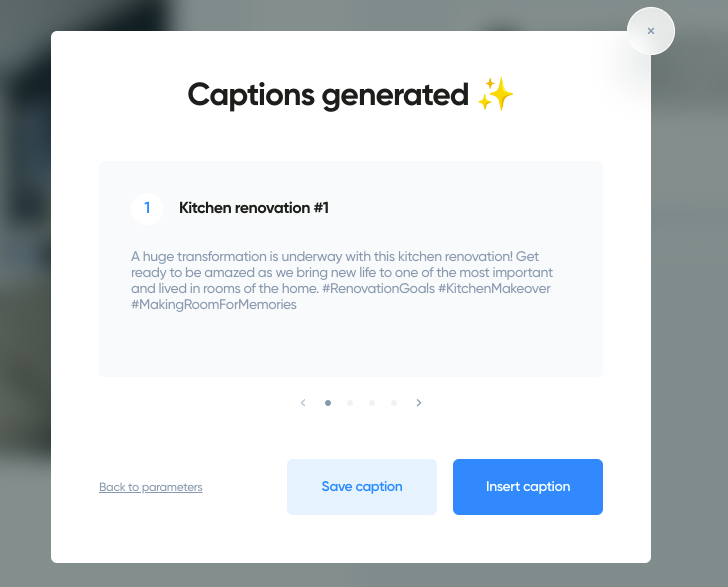 Image created by Iconosquare, March 2023
Image created by Iconosquare, March 2023Step 5: Automatically Get Generated High-Conversion Hashtags
The first caption has a great hook and high-conversion hashtag suggestions.
Instead of broad, overused hashtags like #interiors or #kitchen, the AI caption generator has proposed more specific hashtags like #makingroomformemories.
Step 6: Make Any Manual Edits Necessary
The second caption is great and requires very little editing. I could add some more specific detail about what the renovation process entailed, otherwise this caption is good to go.
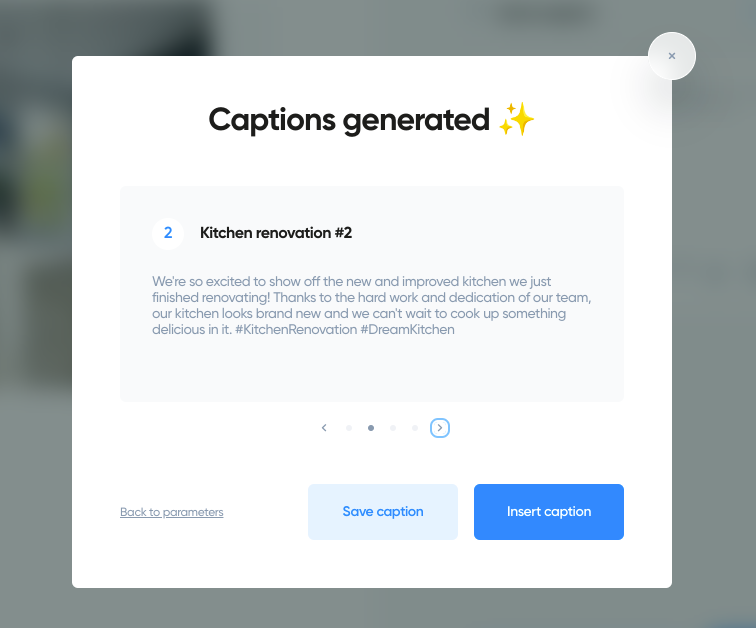 Image created by Iconosquare, March 2023
Image created by Iconosquare, March 2023
 Image created by Iconosquare, March 2023
Image created by Iconosquare, March 2023The third caption has that specificity – “quartz countertops, sleek countertops, and energy-efficient appliances.”
Even if these aren’t exactly right, you now have a template to use to write your caption without having to think about it.
If you’re not totally happy with the first three options, you can generate three more.
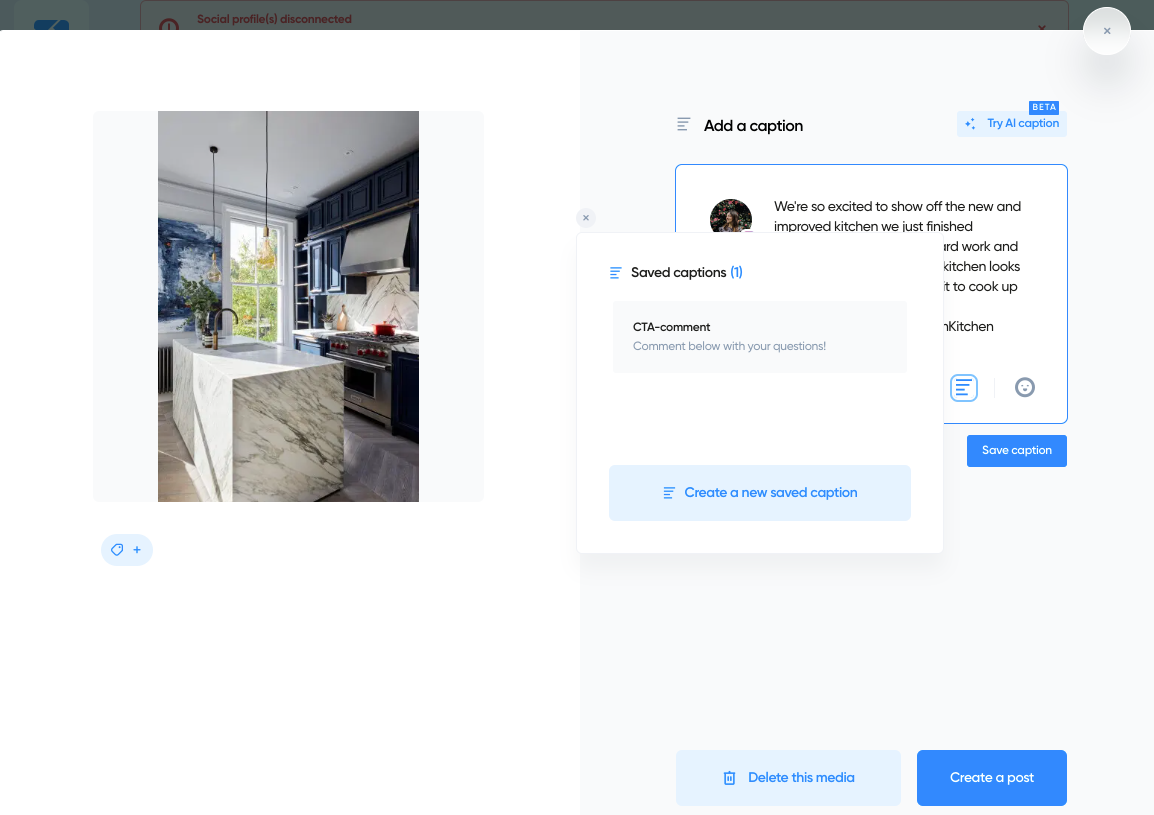 Image created by Iconosquare, March 2023
Image created by Iconosquare, March 2023As for specific calls-to-action (CTAs) like “comment below” or “tag a friend,” you can easily add these to the finished AI-generated captions by selecting one of your “Saved captions.”
Why AI-Generated Content Won’t Make Your Job Redundant
If you’re worried about being replaced by AI, don’t worry.
Despite what you may read online, AI isn’t about to make your job obsolete.
Instead, AI is a great collaborator.
It automates repetitive tasks and sifts through millions of data points to produce actionable recommendations.
This frees up your time and empowers you and your team to create better content and campaigns that deliver their client results.
AI-powered social media tools unlock your potential.
Rather than wasting time and expertise on repetitive tasks like manually posting Reels, you can focus on areas you’re passionate about and uniquely qualified to handle.
Even applications that aid creativity – like Iconosquare’s AI Captions – aren’t cause for concern about the future of your job.
Features like these only enhance and accelerate your creativity.
Again, AI social media tools are perfect for marketers who are juggling multiple clients and complex campaigns.
AI tools can’t replace the empathy, perspective, and storytelling that a human brings to marketing. And this is what it takes to truly connect with customers.
So, don’t worry about AI taking over the world – instead see these applications for what they are: an opportunity to make you an even better social media manager.
Want to try out Iconosquare’s AI caption generator for yourself? You can here!
Say Goodbye To Writer’s Block & Hello To AI-Generated Captions
If you’re ready to harness the power of AI-human collaboration, you have to try Iconosquare’s new AI caption generator.
It’s the perfect tool for generating engaging captions (for LinkedIn, Twitter, and Instagram) that are relevant to whichever brand you’re working on, whether you’re short of time or in need of a creative boost.
Just write out the subject of your post, brand name, and industry, and Iconosquare will generate a list of potential captions. You then pick your favorite and add it to your post in one click.
Image Credits
Featured Image: Image by Iconosquare. Used with permission.
SEO
Google’s Search Engine Market Share Drops As Competitors’ Grows

According to data from GS Statcounter, Google’s search engine market share has fallen to 86.99%, the lowest point since the firm began tracking search engine share in 2009.
The drop represents a more than 4% decrease from the previous month, marking the largest single-month decline on record.
U.S. Market Impact
The decline is most significant in Google’s key market, the United States, where its share of searches across all devices fell by nearly 10%, reaching 77.52%.
 Screenshot from: https://gs.statcounter.com/search-engine-market-share/, May 2024.
Screenshot from: https://gs.statcounter.com/search-engine-market-share/, May 2024.Concurrently, competitors Microsoft Bing and Yahoo Search have seen gains. Bing reached a 13% market share in the U.S. and 5.8% globally, its highest since launching in 2009.
Yahoo Search’s worldwide share nearly tripled to 3.06%, a level not seen since July 2015.
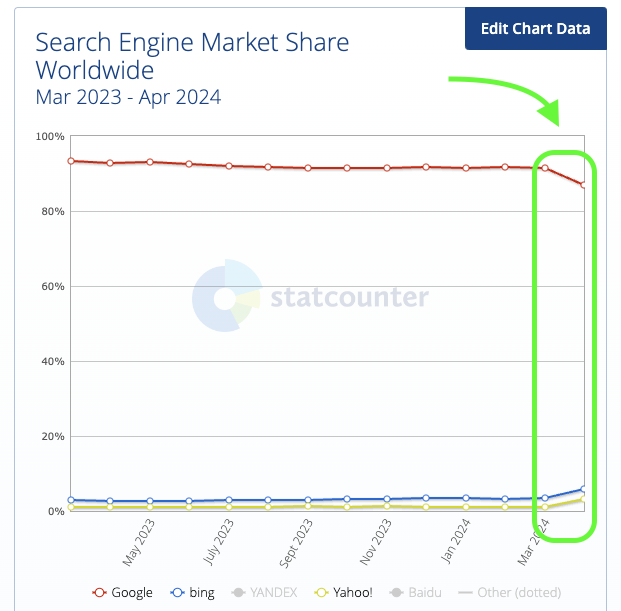 Screenshot from: https://gs.statcounter.com/search-engine-market-share/, May 2024.
Screenshot from: https://gs.statcounter.com/search-engine-market-share/, May 2024.Search Quality Concerns
Many industry experts have recently expressed concerns about the declining quality of Google’s search results.
A portion of the SEO community believes that the search giant’s results have worsened following the latest update.
These concerns have begun to extend to average internet users, who are increasingly voicing complaints about the state of their search results.
Alternative Perspectives
Web analytics platform SimilarWeb provided additional context on X (formerly Twitter), stating that its data for the US for March 2024 suggests Google’s decline may not be as severe as initially reported.
From our data (Search Engine website category, US, March 2024) it doesn’t look like we’re there yet: pic.twitter.com/RBUJp4ZLeb
— Similarweb (@Similarweb) May 1, 2024
SimilarWeb also highlighted Yahoo’s strong performance, categorizing it as a News and Media platform rather than a direct competitor to Google in the Search Engine category.
Don’t underestimate Yahoo. They’re doing great. On our platform they’re categorized as News and Media, and hence not a direct competitor to Google in the Search Engine category. But they rank #10 worldwide, #6 in the US, and #1 in their category. Much higher than Bing and OpenAI. pic.twitter.com/O4yJu5QEK6
— Similarweb (@Similarweb) May 2, 2024
At the same time, Google is slightly declining 👀 pic.twitter.com/9i7paeU1QG
— Similarweb (@Similarweb) May 2, 2024
Why It Matters
The shifting search engine market trends can impact businesses, marketers, and regular users.
Google has been on top for a long time, shaping how we find things online and how users behave.
However, as its market share drops and other search engines gain popularity, publishers may need to rethink their online strategies and optimize for multiple search platforms besides Google.
Users are becoming vocal about Google’s declining search quality over time. As people start trying alternate search engines, the various platforms must prioritize keeping users satisfied if they want to maintain or grow their market position.
It will be interesting to see how they respond to this boost in market share.
What It Means for SEO Pros
As Google’s competitors gain ground, SEO strategies may need to adapt by accounting for how each search engine’s algorithms and ranking factors work.
This could involve diversifying SEO efforts across multiple platforms and staying up-to-date on best practices for each one.
The increased focus on high-quality search results emphasizes the need to create valuable, user-focused content that meets the needs of the target audience.
SEO pros must prioritize informative, engaging, trustworthy content that meets search engine algorithms and user expectations.
Remain flexible, adaptable, and proactive to navigate these shifts. Keeping a pulse on industry trends, user behaviors, and competing search engine strategies will be key for successful SEO campaigns.
Featured Image: Tada Images/Shutterstock
SEO
How To Drive Pipeline With A Silo-Free Strategy

When it comes to B2B strategy, a holistic approach is the only approach.
Revenue organizations usually operate with siloed teams, and often expect a one-size-fits-all solution (usually buying clicks with paid media).
However, without cohesive brand, infrastructure, and pipeline generation efforts, they’re pretty much doomed to fail.
It’s just like rowing crew, where each member of the team must synchronize their movements to propel the boat forward – successful B2B marketing requires an integrated strategy.
So if you’re ready to ditch your disjointed marketing efforts and try a holistic approach, we’ve got you covered.
Join us on May 15, for an insightful live session with Digital Reach Agency on how to craft a compelling brand and PMF.
We’ll walk through the critical infrastructure you need, and the reliances and dependences of the core digital marketing disciplines.
Key takeaways from this webinar:
- Thinking Beyond Traditional Silos: Learn why traditional marketing silos are no longer viable and how they spell doom for modern revenue organizations.
- How To Identify and Fix Silos: Discover actionable strategies for pinpointing and sealing the gaps in your marketing silos.
- The Power of Integration: Uncover the secrets to successfully integrating brand strategy, digital infrastructure, and pipeline generation efforts.
Ben Childs, President and Founder of Digital Reach Agency, and Jordan Gibson, Head of Growth at Digital Reach Agency, will show you how to seamlessly integrate various elements of your marketing strategy for optimal results.
Don’t make the common mistake of using traditional marketing silos – sign up now and learn what it takes to transform your B2B go-to-market.
You’ll also get the opportunity to ask Ben and Jordan your most pressing questions, following the presentation.
And if you can’t make it to the live event, register anyway and we’ll send you a recording shortly after the webinar.
SEO
Why Big Companies Make Bad Content
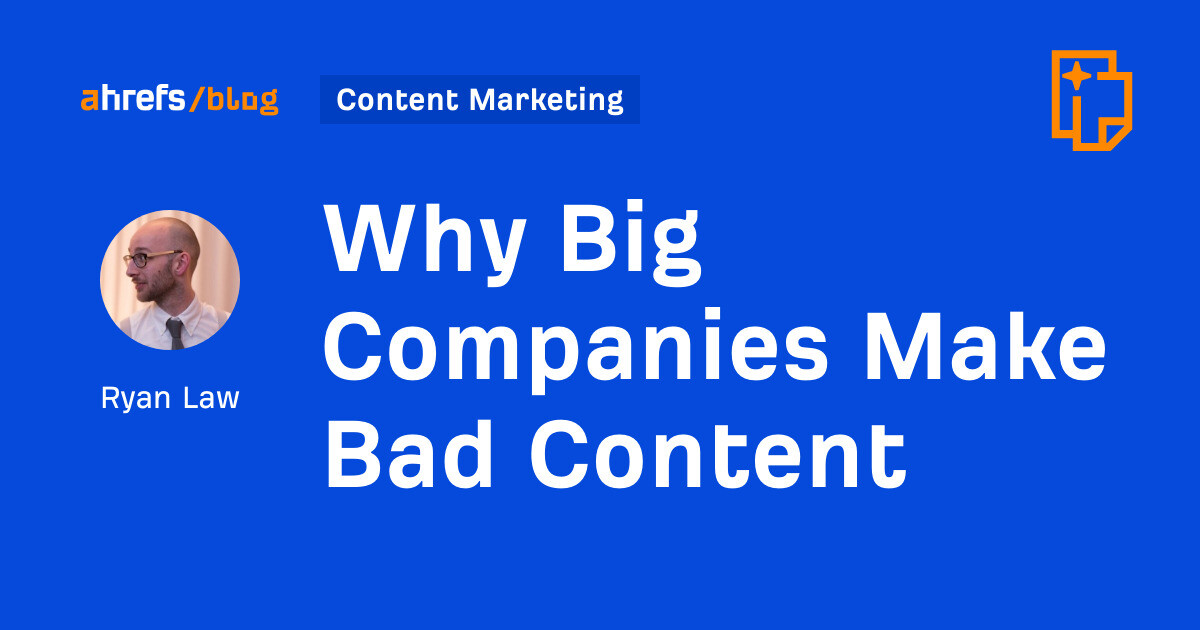
It’s like death and taxes: inevitable. The bigger a company gets, the worse its content marketing becomes.
HubSpot teaching you how to type the shrug emoji or buy bitcoin stock. Salesforce sharing inspiring business quotes. GoDaddy helping you use Bing AI, or Zendesk sharing catchy sales slogans.
Judged by content marketing best practice, these articles are bad.
They won’t resonate with decision-makers. Nobody will buy a HubSpot license after Googling “how to buy bitcoin stock.” It’s the very definition of vanity traffic: tons of visits with no obvious impact on the business.
So why does this happen?
There’s an obvious (but flawed) answer to this question: big companies are inefficient.
As companies grow, they become more complicated, and writing good, relevant content becomes harder. I’ve experienced this firsthand:
- extra rounds of legal review and stakeholder approval creeping into processes.
- content watered down to serve an ever-more generic “brand voice”.
- growing misalignment between search and content teams.
- a lack of content leadership within the company as early employees leave.


Similarly, funded companies have to grow, even when they’re already huge. Content has to feed the machine, continually increasing traffic… even if that traffic never contributes to the bottom line.
There’s an element of truth here, but I’ve come to think that both these arguments are naive, and certainly not the whole story.
It is wrong to assume that the same people that grew the company suddenly forgot everything they once knew about content, and wrong to assume that companies willfully target useless keywords just to game their OKRs.
Instead, let’s assume that this strategy is deliberate, and not oversight. I think bad content—and the vanity traffic it generates—is actually good for business.
There are benefits to driving tons of traffic, even if that traffic never directly converts. Or put in meme format:


Programmatic SEO is a good example. Why does Dialpad create landing pages for local phone numbers?


Why does Wise target exchange rate keywords?


Why do we have a list of most popular websites pages?


As this Twitter user points out, these articles will never convert…
…but they don’t need to.
Every published URL and targeted keyword is a new doorway from the backwaters of the internet into your website. It’s a chance to acquire backlinks that wouldn’t otherwise exist, and an opportunity to get your brand in front of thousands of new, otherwise unfamiliar people.
These benefits might not directly translate into revenue, but over time, in aggregate, they can have a huge indirect impact on revenue. They can:
- Strengthen domain authority and the search performance of every other page on the website.
- Boost brand awareness, and encourage serendipitous interactions that land your brand in front of the right person at the right time.
- Deny your competitors traffic and dilute their share of voice.
These small benefits become more worthwhile when multiplied across many hundreds or thousands of pages. If you can minimize the cost of the content, there is relatively little downside.
What about topical authority?
“But what about topical authority?!” I hear you cry. “If you stray too far from your area of expertise, won’t rankings suffer for it?”
I reply simply with this screenshot of Forbes’ “health” subfolder, generating almost 4 million estimated monthly organic pageviews:


And big companies can minimize cost. For large, established brands, the marginal cost of content creation is relatively low.
Many companies scale their output through networks of freelancer writers, avoiding the cost of fully loaded employees. They have established, efficient processes for research, briefing, editorial review, publication and maintenance. The cost of an additional “unit” of content—or ten, or a hundred—is not that great, especially relative to other marketing channels.
There is also relatively little opportunity cost to consider: the fact that energy spent on “vanity” traffic could be better spent elsewhere, on more business-relevant topics.
In reality, many of the companies engaging in this strategy have already plucked the low-hanging fruit and written almost every product-relevant topic. There are a finite number of high traffic, high relevance topics; blog consistently for a decade and you too will reach these limits.
On top of that, the HubSpots and Salesforces of the world have very established, very efficient sales processes. Content gating, lead capture and scoring, and retargeting allow them to put very small conversion rates to relatively good use.
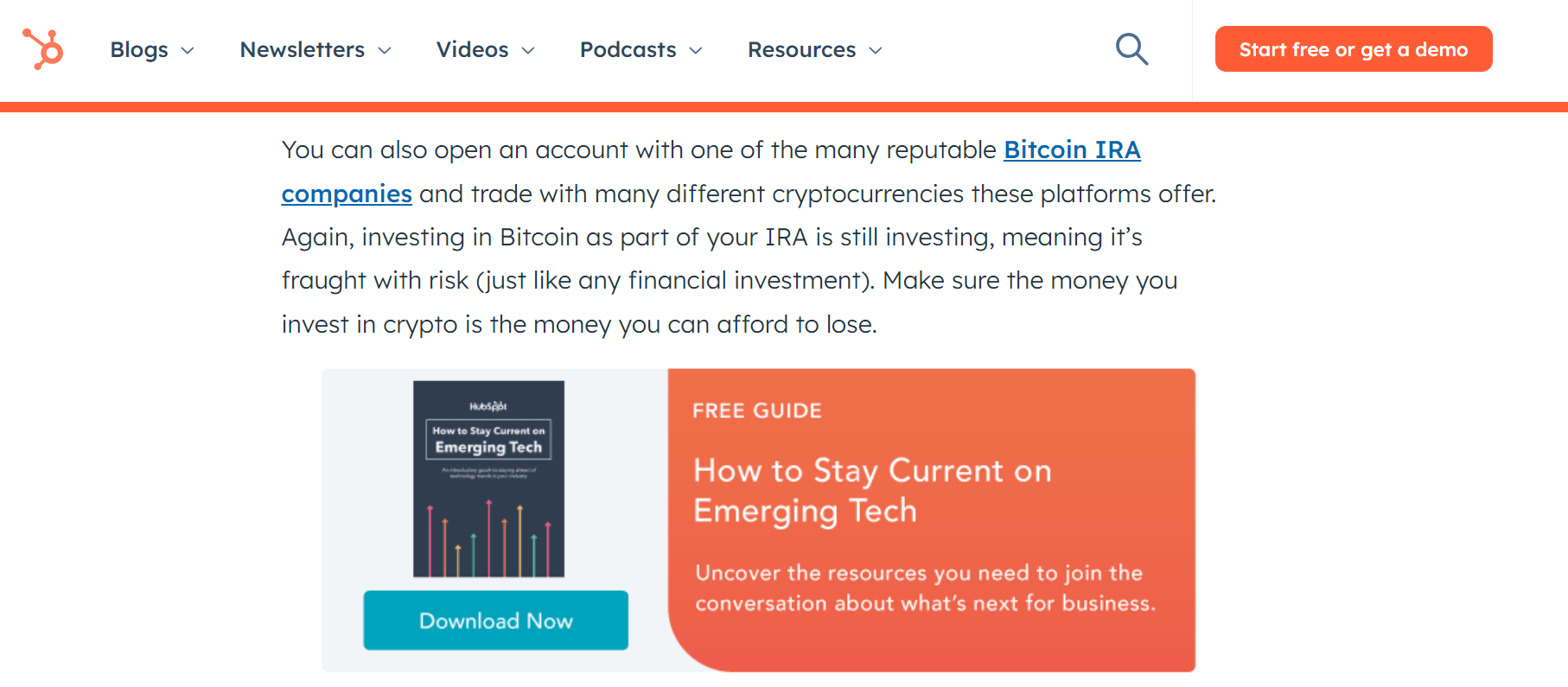

Even HubSpot’s article on Bitcoin stock has its own relevant call-to-action—and for HubSpot, building a database of aspiring investors is more valuable than it sounds, because…
The bigger a company grows, the bigger its audience needs to be to continue sustaining that growth rate.
Companies generally expand their total addressable market (TAM) as they grow, like HubSpot broadening from marketing to sales and customer success, launching new product lines for new—much bigger—audiences. This means the target audience for their content marketing grows alongside.
As Peep Laja put its:
But for the biggest companies, this principle is taken to an extreme. When a company gears up to IPO, its target audience expands to… pretty much everyone.
This was something Janessa Lantz (ex-HubSpot and dbt Labs) helped me understand: the target audience for a post-IPO company is not just end users, but institutional investors, market analysts, journalists, even regular Jane investors.
These are people who can influence the company’s worth in ways beyond simply buying a subscription: they can invest or encourage others to invest and dramatically influence the share price. These people are influenced by billboards, OOH advertising and, you guessed it, seemingly “bad” content showing up whenever they Google something.
You can think of this as a second, additional marketing funnel for post-IPO companies:


These visitors might not purchase a software subscription when they see your article in the SERP, but they will notice your brand, and maybe listen more attentively the next time your stock ticker appears on the news.
They won’t become power users, but they might download your eBook and add an extra unit to the email subscribers reported in your S1.
They might not contribute revenue now, but they will in the future: in the form of stock appreciation, or becoming the target audience for a future product line.
Vanity traffic does create value, but in a form most content marketers are not used to measuring.
If any of these benefits apply, then it makes sense to acquire them for your company—but also to deny them to your competitors.
SEO is an arms race: there are a finite number of keywords and topics, and leaving a rival to claim hundreds, even thousands of SERPs uncontested could very quickly create a headache for your company.
SEO can quickly create a moat of backlinks and brand awareness that can be virtually impossible to challenge; left unchecked, the gap between your company and your rival can accelerate at an accelerating pace.
Pumping out “bad” content and chasing vanity traffic is a chance to deny your rivals unchallenged share of voice, and make sure your brand always has a seat at the table.
Final thoughts
These types of articles are miscategorized—instead of thinking of them as bad content, it’s better to think of them as cheap digital billboards with surprisingly great attribution.
Big companies chasing “vanity traffic” isn’t an accident or oversight—there are good reasons to invest energy into content that will never convert. There is benefit, just not in the format most content marketers are used to.
This is not an argument to suggest that every company should invest in hyper-broad, high-traffic keywords. But if you’ve been blogging for a decade, or you’re gearing up for an IPO, then “bad content” and the vanity traffic it creates might not be so bad.
-

 WORDPRESS7 days ago
WORDPRESS7 days ago9 Best WooCommerce Multi Vendor Plugins (Compared)
-

 SEO6 days ago
SEO6 days agoGoogle March 2024 Core Update Officially Completed A Week Ago
-

 MARKETING5 days ago
MARKETING5 days agoNavigating the Video Marketing Maze: Short-Form vs. Long-Form
-

 SEARCHENGINES6 days ago
SEARCHENGINES6 days agoGoogle March 2024 Core Update Finished April 19, 2024
-
![The Current State of Google’s Search Generative Experience [What It Means for SEO in 2024] person typing on laptop with](https://articles.entireweb.com/wp-content/uploads/2024/04/The-Current-State-of-Googles-Search-Generative-Experience-What-It.webp-400x240.webp)
![The Current State of Google’s Search Generative Experience [What It Means for SEO in 2024] person typing on laptop with](https://articles.entireweb.com/wp-content/uploads/2024/04/The-Current-State-of-Googles-Search-Generative-Experience-What-It.webp-80x80.webp) MARKETING6 days ago
MARKETING6 days agoThe Current State of Google’s Search Generative Experience [What It Means for SEO in 2024]
-
SEARCHENGINES5 days ago
Daily Search Forum Recap: April 26, 2024
-

 WORDPRESS6 days ago
WORDPRESS6 days agoNew WordPress.com Themes for April 2024 – WordPress.com News
-

 SEARCHENGINES4 days ago
SEARCHENGINES4 days agoOffline For Last Days Of Passover 5784














